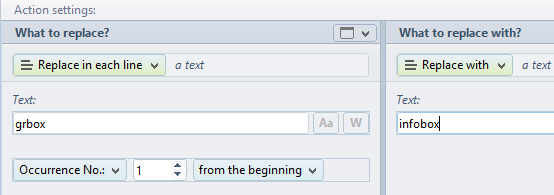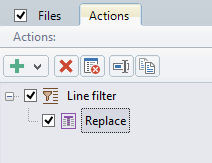Integration into the Windows Interface
Start program from the Windows Interface
Just double-click the program icon on your desktop or start the program from the Windows Start Menu.
Use context menu
Right click on the files you would like to rename, select the Send To menu and then Batch Text Replacer.
"Drag & Drop" support
Batch Text Replacer supports "Drag & Drop". For example, you can drag files to be edited onto its program icon.
Manage files

Add files or folders
Opens a selection dialog in which you can select the text files to be edited or their parent folders.
File list menu
This menu contains various entries to adjust the status of the list items (e.g., "select all entries").
File filter
Clicking on this button opens the dialog for specifying the file filter settings. The number at the end of the label shows the current number of filtered files.
Correct the auto-detected encoding

Batch Text Replacer tries to detect the encoding of the added text files automatically. For some files, this is not possible with absolute certainty. In this case it is possible to
correct the automatically detected encoding for the selected list entries.
Actions

There are various types for the editing of the text (for example, Replace, Insert). These types are called actions. Actions consist mostly of two areas. In one area is
defined which part of the text should be edited. The other area is used to define the way in which this part of the text is to be changed or adjusted. Actions can be combined
and are applied in the order they occurred. The actions including the filter and sort settings can be saved in a profile.
Action types
Edit text
This action type is used to edit text with one or more lines. An application example of this action type would be to edit (e.g,, replace or move) a paragraph. Specifying a particular occurrence refers to the beginning or end of the text.
Edit line text
This action type is used to edit an area or text within each line. An application example of the action type would be to edit (e.g,, replace or move) word number 1 to 3 in all lines.
Specifying a particular occurrence refers to the beginning or the end of line.
Edit lines
This action type is used to edit complete rows (rows are considered as objects). An application example of this action type would be to edit (e.g,, replace or move) the first 10 rows. Specifying a particular occurrence refers to the beginning or end of the text.
Store in variable
This action type is used to store text or lines in variables for later processing. An application example of this action type would be to save the first paragraph in a variable, remove the surrounding area and then insert the content of the variable to a new position.
Variables can be included within text parameters by using the notation "{variable1}" or "{My_Variable}". An example: (replace with --> text --> Order No. {MyVar1} from {MyVar2}" - the result might be "Order No. 7 from March, 20 2013".
Action groups
Action groups serve to accommodate actions that should be applied only to a portion of the text or only on certain lines. To narrow down the text to edit, there are several tools available in Batch Text Replacer. For example, using the area limiter, the beginning and the end of the text to be edited can be limited. Action groups can be nested together. Another action group is the "repeater", which allows the repeated execution of the actions contained.
Change Encoding
This action type allows you to change the encoding of a text (e.g., from ANSI to UTF-8) as well as the encoding of newline characters.
Regex
Batch Text Replacer supports Perl Compatible Regular Expressions. These can be used in almost all of the input fields by activating the "Rx" button.
When using the Replace function, back references are possible by using "Replace with --> a text".
You can find information about the syntax on the following pages:
Action list

In the action list, all actions are summarized. Their order will be considered in
the calculation of the new text. Actions can be individually named for clarity. It is
possible to deactivate an action. The order of actions can be determined by moving
the entries using Drag & Drop. For reuse, the actions (including the disabled) can be
stored as a profile.
 Add action
Add action
 Remove action
Remove action
 Clear action list
Clear action list
 Name action individually
Name action individually
 Duplicate action
Duplicate action
Manage profiles
A profile consists of one or more actions as well as the settings of the file filter.
The profile overview contains all self-generated profiles as well as the enclosed templates.
Categories:
For a better overview, the profiles can be stored in different categories.
Edit profiles:
User-created profiles can be renamed, deleted and imported or exported.
Preview

In the preview, the effect of the changes on the selected file list entry or the
entered text in real time are displayed. This allows for a check in advance of the outcome.
Toolbar
Set preview mode
One can choose between a detailed preview and the standard preview. In the detailed
preview the differences are highlighted for clarity; in contrast to standard preview
where due to the complex calculation a maximum of 100,000 lines is displayed.
 Always jump to the first difference
Always jump to the first difference
 Scroll vertical synchronously
Scroll vertical synchronously
 Cut selected text
Cut selected text
 Copy selected text to the clipboard
Copy selected text to the clipboard
 Paste from clipboard
Paste from clipboard
 Select all
Select all
Line background colors
-
Yellow background
This background color is displayed above and below a section with changes.
-
Red background
This background color indicates the lines of a section with changes.
Output
Output Settings
- Overwrite existing files
Optionally, the modified files can be stored in a restorable ZIP archive.
In the Restore dialog, the changes to the files can be undone.
-
Create new files
When activated, the output is made into a newly created file with a
file name based on the original file name including a time stamp as suffix.
Optionally, existing files can be overwritten.
Output
Displays the status of the files to be written in a list.

File filter
By using the filter, the files to be processed can be limited. Filters can be combined.
For many comparison operations, multiple terms separated by the "|" character can be entered
(e.g., htm|css|txt). When deactivated, the filter must be reactivated manually.
Filters are also saved as part of profiles.
File search
The file search can be used to limit the files to be processed. It is divided into three steps.
Step 1 - Specifying the search location
Either the program file list or a folder, selected through the folder selection dialog can serve as search location/source.
In addition, some files can be excluded using the filter and optionally, sub-folders can be searched.
Step 2 - Define the search parameters
You can enter single-line or multi-line search terms. The following options are available:
-
Match case
Determines whether the case of the entered search term will be evaluated.
-
Compare whole words only
Determines whether a separating character should be in front of and behind the reference.
-
Ignore surrounding whitespace in all lines of the search term
Determines if the search term is searched for independently of leading and trailing spaces.
-
Interpret search term as regular expression
Determines if the search term is evaluated as a Perl-compatible regex.
-
Use as a placeholder for exactly one character
When enabled, the specified characters is evaluated as a wildcard for a single character (for example, allows finding Doe via D?e).
-
Use as a placeholder for several (even none)
When enabled, the specified character is evaluated as a wildcard for multiple or none characters (for example, allows finding Doe on D*).
Step 3 - Validation of results and optional further processing
The references are listed in a tree view. In each branch the line numbers are contained, in which the search term was found.
If you click on a list entry, the corresponding line is displayed in the overlying preview.
For further processing, you can choose from the following options:
- Add to Batch Text Replacer's file list (with prior emptying)
- Add to Batch Text Replacer's file list
- Save as file list...
- Copy to Clipboard
- Open with default text editor
As an option, by clicking on the "Next (optional)"-button, an additional search within the matching files starts to further narrow down the result.
Statusbar
Program status
Displays the status when executing a function that could take an extended
amount of time (e.g., reading files).
When reading files and folders, the button Cancel Process is displayed.
You can cancel the reading process by clicking on this button.
Hints
Displays brief information about the user elements beneath the mouse cursor.
Preview status
When activated, the changes to all files are pre-calculated.
Options
Program
-
Search for updates at program start
Checks at each program start, if a new version of Batch Text Replacer is available.
-
Default Text Editor
Sets the external text editor, with which the currently selected files can be viewed or opened for inspection.
Backups
-
Limit number of backups to
Here, the maximum number of backups to be stored can be set.
-
Confirm automatic deletion
When exceeding the maximum number of backups to be stored, the automatic deletion of the extra backups must be confirmed.
Confirmations
-
Clear action list
Determines whether the emptying of the action list should be confirmed.
Other
-
Do not read files with binary content (recommended)
Since an error-free processing of files with binary content (e.g., jpg, docx, avi, xls) can not be guaranteed,
it is recommended to leave this option enabled.
Exclusion
The exclusion filter allows you to exclude unwanted files or folders in advance of processing (e.g., DLLs, Temp folder, etc.).
Unlike to using the profile filter, objects excluded here are not kept. Therefore, there is no time-consuming testing.
Command line
Syntax
- BatchTextReplacer /"File to read #1|#2|#3|..." [Options]
- BatchTextReplacer /folderselectionlist " Path to a FSL file (folder selection list)" [Options]
- BatchTextReplacer /textfile " Path to a TXT file" [Options]
Note: FSL files are simple text files with a line-by-line listing of one or more folder paths.
Example
BatchTextReplacer /"D:\Data\1.txt| D:\Data\2.txt " /profilefilename "D:\My Profiles\Text replacement (final).TmProfile"
Options (Profiles)
| Parameter |
Description |
| /profilefilename |
"Path of the profile to use" |
| /profile |
"Profile category|Profile name"
e.g., "HTML|Header correction"
|